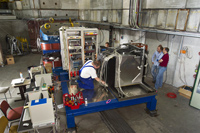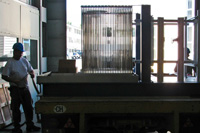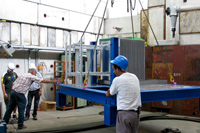 |
 |
|||||||||||||
|
|||||||||||||
|
|||||||||||||
|
In a hall for test beam experiments at CERN, next to the CLOUD climate experiment and an irradiation facility, sits a detector prototype that is in many ways a first. It's the first ever hadronic sandwich calorimeter (HCal) prototype made of tungsten. It's the first prototype for a detector for the Compact Linear Collider Study CLIC, developed by the linear collider detector R&D group (LCD group) at CERN. And it's the first piece of hardware that results directly from the cooperation between CLIC and ILC detector study groups. Now its makers are keen to see first particle showers in their detector.
The tungsten calorimeter has just moved from a workshop at CERN, where it was assembled from finely polished tungsten squares and triangles, into the test hall. It consists of 30 tungsten plates that are one centimetre thick and some 80 centimetres wide. Last week the 30 plates, which serve as absorber in the calorimeter, were kitted out with layers of scintillators, the detectors that record what happens when particles get stopped in the tungsten and create showers of other particles. The scintillators, each sandwiched between two layers of tungsten, are imports from the CALICE collaboration: they form part of the CALICE HCal calorimeter and are thus well calibrated and understood. The CALICE team, flown in from DESY, cabled it all up and prepared it for its first tests with real particles, first with muons, then from November on with hadrons. Tungsten does not sound like an ideal material for building a detector. It is brittle, it is expensive, it has the highest melting point of all metals, meaning that you could never liquefy it in a melting pot — the pot would melt first. But tungsten also has a number of advantages, especially for scientists who want to study particle showers from collisions in detectors and measure each particle with a method called particle flow. It is extremely dense, which means that it could make the subdetectors that need dense material – calorimeters – much smaller and could thus mean cost savings in the outer components, notably the magnetic coil and return yoke. The density of tungsten makes it the best absorber for the high-energy particles spraying out from the 3-TeV collisions at CLIC. A calorimeter measures the energy of passing particles, and in order to do that it needs to make them interact first. That is why a calorimeter consists of several different layer sandwiches: a dense absorber material (for example iron or tungsten) followed by the 'detector layer' that records the passing particles from the particle shower. While there are a number of electromagnetic calorimeters that use tungsten as absorber, this one is the first hadronic sandwich calorimeter. “It studies different kinds of particles,” explains Lucie Linssen, head of the LCD group at CERN, “and we ran many, many simulations to convince ourselves that it would work. Now we're looking forward to feeding the real data back into the simulation software GEANT4.” During the simulations the team already found one tungsten speciality that might cause a problem in the frequent high-energy bunch crossings at CLIC: the development of a particle shower in the tungsten absorber is slower than in steel, making it harder to distinguish particles from different bunch crossings. “We're looking at two solutions — one is called time sampling, which is also done at the LHC," says Linssen. The other is opting for 'classic' iron in the calorimeter's forward regions — most overlaying showers would be created in the forward direction rather than around the interaction region. “In any case we have to carefully test the tungsten's behaviour to validate our simulations.” Three of the sandwich slots between the tungsten plates are still empty and will be kitted out in the next few weeks with different layers of detectors. One is a scintillator layer with especially fast readout electronics, developed by the Max Planck Institute of Physics in Munich (read also Frank Simon's blog). Others are gaseous detectors: resistive plate chambers (RPCs) or Micromegas, all part of the global linear collider physics and detector development. The ultimate goal is to make the detector layers between the tungsten plates as narrow as possible, thus reducing the size of the whole calorimeter and save money in the magnet. In the future another ten absorber layers will be added and the tungsten calorimeter will pass through a variety of test beams at different energies. According to CALICE spokesman Felix Sefkow, the studies will benefit all developers of future detectors, independent of the collider they are developing them for. “We're looking forward to the test results because the hadronic behaviour of tungsten is largely unexplored,” says Sefkow. “These are real text book studies for calorimetry.” -- Barbara Warmbein |
|||||||||||||
| © International Linear Collider |


